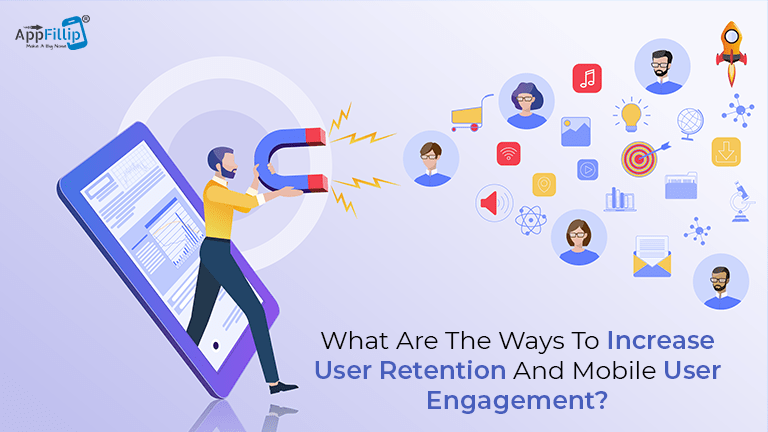What Are The Ways To Increase User Retention And Mobile User Engagement?

With over 250+ million apps daily installs in 2019–2020, there’s a clear indication that conversion potential is infinite now. Given the rise of internet consumption on mobile devices, the golden period for mobile apps has begun.
But not every developer is fortunate enough! A few apps are either deleted or rarely used daily. It is because – the key to an app’s success lies in its “retention rate,” which has been ignored by most.
It is a powerful element that turns a curious user into a long-term customer. Here’s how it works, and how anyone can increase mobile user engagement by simply taking the Retention Rate up.
Why Is Retention Rate Important?
Retention refers to a term that defines how long a user is on a platform (e.g., a mobile application). Similarly, the term “retention rate” refers to a metric that describes the duration a user has been retained on a platform.
The higher user retention rate means that an app is doing pretty well, while the lowest rate means that people don’t like the app that much.
For example, a typical user can easily spend 1 to 6 hours on an application. If they are still in this routine, spending similar time for days, weeks, and months, that means an app has a strong retention rate.
Retention vs. User Acquisition
Retention and User Acquisition—are the two precious components that make an app launch a big success. An application acquires new or some early users to grab more installs, but the strategy can’t promise growth if it has less retention power.
People coming via User Acquisition aren’t guaranteed to remain on the application if it lacks features, functions, and techniques that could keep them for a long time on the app.
Ideal Mobile App Retention Rate
A study on 31 apps downloaded by multiple users to monitor the worldwide retention rate on mobile applications shows that apps had a 25.3% average retention rate on day 1.
By day 30, the average retention rate had slipped down to 5.6%. In a nutshell, a 20% average retention rate is good for mobile apps, and it is awesome if it is equal to or above 25%.
User Retention and App Engagement Metrics
Below are the key metrics that may help you decide whether your app is living up to your hopes or preparing for disappointments.
The total number of downloads
Instead of focusing on how many people have downloaded an app, count the intensity and duration within which downloads have been registered. Positive outcomes express the success of app marketing.
Users of Active Mobile Apps
The presence of the most active users on an application on a regular, weekly, or monthly basis indicates high user retention.
Time between sessions
The metric defines how often a user comes in, uses, and comes back to the front.
Session Duration
The metric defines how long a user stays in and uses the app.
Revenue for Life
It’s good if revenue is increasing because high retention is the cause. But if it’s lower, it may be that user retention is weakening.
Some Good Examples of Apps with a High and Low Retention Rate
A gaming app with interactive visuals has a more than 25% retention rate. If the app is addictive and can retain users, it can build an active number of users for life. It may even get app updates frequently. On the other hand, a location tracker app or virus remover app may have a lower retention rate as people use such applications for hardly a few days or minutes.
6 Ways to Improve App User Retention
Let’s get straight to the point on how to increase user retention in an app.
1. Smooth Onboarding Flow
The first impression could be the end of the interaction! So consider keeping the first page of the app as intuitive, easy to navigate, and smooth as you can. In the first 20 seconds, it must serve the purpose of what they have checked into the app.
2. Deliver a Personalized Experience
The more you keep it personalized, the further your mobile app marketing will go and be worth every single penny. Nobody will give importance to an app with unnecessary options and features. So throw them out and keep those that meet their personal needs.
3. Monitor Data From the Beginning
Application data tracking highlights the app usage and user experience. Whether the application is serving the objectives, fulfilling business goals, and deriving meaningful results, keep a check on that from the moment you begin.
4. Gamification Could Be Beneficial.
Don’t stuff it with information! People hate to be taught, but they love to be entertained. Find an entertainment source that you can combine with your application to boost user retention.
5. Continue to make enticing offers.
Try bringing exciting offers to the app. Simply add in-app and mobile push notifications to your application and improve user retention.
Final Words
You have learned the power of great app retention and how to do it. But now it’s time for the implementation. So go ahead.

